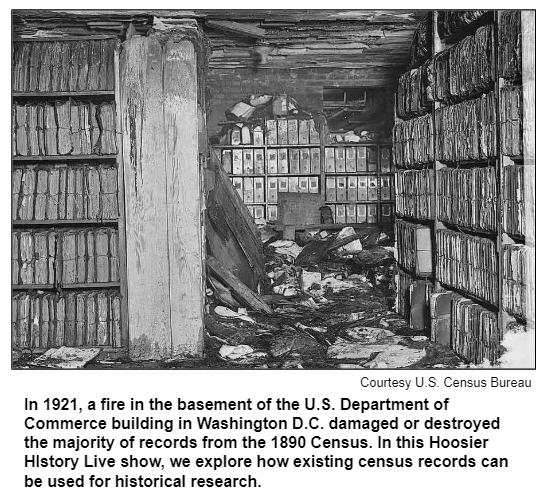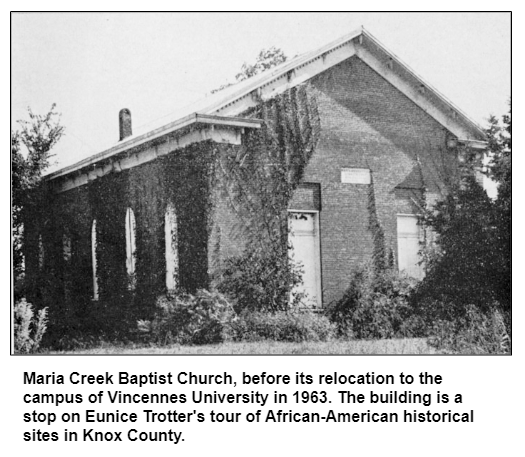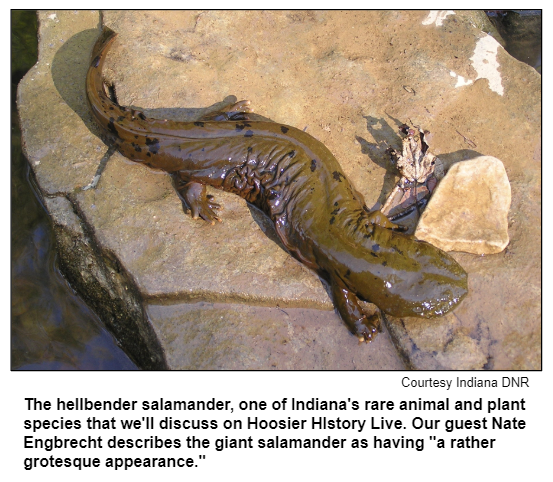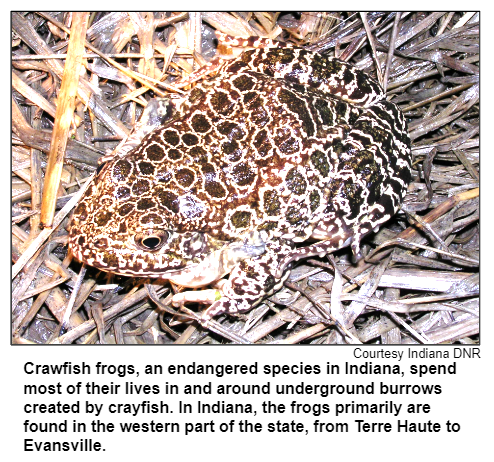
Saturdays, noon to 1 p.m. ET on WICR 88.7 FM.
Or stream audio live from anywhere on WICR Online!
You can listen to recent shows by clicking the podcast links below, or check out our extensive archive of past shows available as podcasts
November 9, 2019
The Census: Tips for using in historic research
As the nation readies itself for the 2020 U.S. Census, Hoosier History Live will take a close look at how records of the previous national headcounts - there have been 23 of them in all, beginning with the first in 1790 - can be used to unearth factual information and illuminate social history, as well as inform us about other aspects of our heritage.

"The first five enumerations listed the number of slaves in each household, and the 1930 enumeration listed whether or not there was a radio in the household," says our guest, Indianapolis-based history researcher Sharon Butsch Freeland.
Sharon regularly uses census information to delve into the history of families and old houses, as well as to investigate historical figures such as the Indianapolis-born wife of Treasure Island author Robert Louis Stevenson. In 2018, Sharon was a guest on our show about the colorful life of Fanny Vandegrift Stevenson. (Sharon's other guest gigs have included our 2017 show about her alma mater, Shortridge High School).
Noting that the census was established by the U.S. Constitution with the purpose of calculating fair representation in the House of Representatives, Sharon adds:

To protect the privacy of living people, census records can't be viewed by the public until 72 years after the census date. Currently, the most recent available for viewing is the 1940 U.S. Census. In 2022, the 1950 U.S. Census will become available.
Some U.S. Census insights, courtesy of Sharon:
- "Digitized census records from 1790 to 1940 can be viewed online at ancestry.com (by subscription) or at familysearch.org for free," she reports. "Ancestry.com is available free of charge at National Archives facilities nationwide and at many public libraries."
- In Indianapolis, the 1870 U.S. Census was collected a second time, during the subsequent year. That's because city leaders had estimated the population to be more than 50,000. When the 1870 Census reported fewer than 41,000, power-brokers in Indianapolis demanded a recount. The 1871 recount was about 19 percent higher.
- In the 1960 U.S. Census, women were asked how many babies they had ever had. Employed people were asked how they got to work: railroad, subway, bus, streetcar, taxi, private auto, car pool, walking, or whether they worked from home. (In 1980, bicycle was added to the list.)
A note about the fire that destroyed most of the 1890 U.S. Census records: The inferno occurred at the U.S. Commerce Building in Washington D.C. Although fragments of information from a few states survived, all of the 1890 records from Indiana were lost in the blaze.
The 2020 U.S. Census will be the first to offer the option of responding online. That's the method the Census Bureau expects most people to use to answer the questions, although respondents also can call a phone number to provide their answers. "Those who don't respond will receive paper questionnaires in the mail," according to an Associated Press report about next year's process. "If all those methods fail, the bureau will send out 'enumerators' to knock on doors."
Our guest Sharon Butsch Freeland has a family connection to census-taking: Her maternal grandmother, Catharine Tomlinson, was an enumerator for the 1930 U.S. Census, knocking on doors in the Indianapolis neighborhood where she lived with her family.
A decade earlier, the 1920 Census had determined that more Hoosiers were living in urban areas than rural ones. The percentage of rural residents in Indiana has declined noticeably in every census since then.
Roadtrip: Knox County and African-American heritage
Guest Roadtripper and veteran journalist Eunice Trotter invites us to join her for a look into historic sites related to African-American history in Vincennes, the territorial capital of Indiana before it became a state in 1816, as well as locations in surrounding Knox County.
Eunice tells us that African Americans either helped to construct or later worked on several historic sites in Vincennes, including Grouseland, the elegant Georgian/Federal home of William Henry Harrison and his family when he was Governor of the Indiana Territory.
Other sites where early black Hoosiers made significant contributions: the Elihu Stout print shop, printer of Indiana's first newspaper, the Indiana Gazette, and the Old French House, home of French fur trader Michel Brouillet (1774-1838). At one time, Knox County had the largest African-American population in the state.
Next stop on Eunice's Roadtrip: the campus of Vincennes University, home of Maria Creek Chapel. Founded in 1809 as Maria Creek Baptist Church, it was relocated from its original spot on the outskirts of the city in 1963 after being abandoned in 1947. The 12 Knox County residents who originally founded the church include John Morris, a former slave. The church denied membership to slave owners.
Other points of interest on Eunice's tour of the area include several black neighborhoods and churches, as well as a historical marker memorializing Mary Bateman Clark, Eunice's great-great-great grandmother, whose successful lawsuit led to an Indiana Supreme Court decision banning indentured servitude.
Join Eunice to hear the fascinating details of this African-American themed Roadtrip into Hoosier history!
History Mystery

As reported in the 2010 census, most of the states that border Indiana also had population increases, with one exception. That state actually lost people between 2000 and 2010. The other bordering states gained people, butmost of their percentage increases fell below the 6.6 percent growth in Indiana.
Question: What state bordering Indiana lost population between 2000 and 2010?
The call-in number is (317) 788-3314. Please do not call into the show until you hear Nelson pose the question on the air, and please do not try to win the prize if you have won any other prize on WICR during the last two months. You must be willing to give your name and address to our engineer and be willing to be placed on the air.
The prizes this week are two tickets to the Indiana History Center, courtesy of the Indiana Historical Society, and two tickets to the Eiteljorg Museum, courtesy of the Eiteljorg Museum.
Please share our podcasts!
The world of podcasting is a bit like the Wild, Wild West, and Hoosier History Live is trying to stake its claim on the frontier by spreading our show in the Territories of Apple Podcasts, Google Play, and the like.
No, we're not going to shoot it out at the OK Corral with This American Life, but we need your help if we are going to prosper in this new, somewhat-still-uncharted land.
If you love Hoosier History Live, please help us out by posting our podcasts to your social media accounts and sharing your enthusiasm for particular shows with your friends.
Do you have questions about how to listen by streaming or download our podcasts? Unsure about how to repost? Contact producer molly@hoosierhistorylive.org or webmaster mick@hoosierhistorylive.org.
Nelson Price, host and historian
Molly Head, producer/general manager, (317) 927-9101
Michael Armbruster, associate producer
Cheryl Lamb, administrative manager
Richard Sullivan, senior tech consultant
Pam Fraizer, graphic designer
Garry Chilluffo, special events consultant
Please tell our sponsors that you appreciate their support!

 For organizational sponsorship, which includes logos, links, and voiced credits in the show and in podcasts, contact producer Molly Head at (317) 927-9101 or email her at molly@hoosierhistorylive.org. Our podcast listens are increasing at a rate of 17% a month!
For organizational sponsorship, which includes logos, links, and voiced credits in the show and in podcasts, contact producer Molly Head at (317) 927-9101 or email her at molly@hoosierhistorylive.org. Our podcast listens are increasing at a rate of 17% a month!
Acknowledgments to Visit Indy, Fraizer Designs,WICR-FM, Henri Pensis, Aaron Duvall, Chloe Tyson, and many other individuals and organizations.
Thank you!
We'd like to thank the following recent, new and renewal contributors whose donations help make this show possible!
- Bruce and Julie Buchanan
- David Willkie
- Coby Palmer in memory of Gary BraVard
- Tim Harmon
November 16, 2019 - coming up
Rare plants and animals in Indiana

Both are native to the Hoosier state, but only in isolated places. And both will be among the seldom seen plants and animals that we feature on this show dedicated to Indiana's botanical and zoological rarities.
Nelson will be joined in studio by botanist Michael Homoya, who retired last year after a distinguished career with the Indiana Department of Natural Resources, and by herpetologist Nate Engbrecht, who is based in Indiana DNR's Bloomington office.
According to Nate, who specializes in the study of reptiles and amphibians, the hellbender is "a large - two feet or longer - fully aquatic salamander” that has become an endangered species in Indiana, where the only known remaining population is in the Blue River near O'Bannon Woods State Park. Nate describes hellbenders this way:
"They are generally brownish in color and have a rather grotesque appearance with loose-looking folds of skin and small, diminutive eyes. They spend much of their lives under rocks in cooler, well-oxygenated streams."
Regarding orange-fringed orchids: In Indiana, they are known to exist only in the far northern part of the state, according to Michael. One of 45 species of wild orchids that have been seen in Indiana (although a few of them are no longer present), orange-fringed orchids are visible from a trail in Fisher Oak Nature Preserve in Jasper County.
Orange-fringed orchids are more common in southern Michigan and in the southeastern United States, Michael says.
Our guests also will share insights about other rare plants and animals, including
- Crawfish frogs. Like hellbenders, they are an endangered species in Indiana. According to Nate, crawfish frogs ("a big one is about the size of your fist") are "secretive," spending most of their lives in and around underground burrows created by crayfish. "They essentially depend on the crayfish to create their burrows for them," Nate says. In Indiana, the frogs primarily are found in the western part of the state, from Terre Haute to Evansville.
- Mosquito ferns. "This plant is fascinating - the world's smallest fern," Michael says. For Outdoor Indiana magazine, he wrote an article about the fern, which can be seen in Twin Swamps Nature Preserve in southwestern Indiana.
- And green salamanders. Describing them as "rare gems among southern Indiana amphibians," Nate calls attention to their "striking" green coloration and intriguing habitat. Green salamanders are seen in a small area near the Ohio River in Crawford and Perry counties.
Although this will be Nate's first appearance on Hoosier History Live, Michael has been a guest several times, including on a Bicentennial-themed show about what the state's terrain looked like in 1816, the year Indiana became the 19th state.
Michael also is the co-author of a new book, Wake Up, Woods (Cardinal Publishing) that introduces children to the biodiversity of Indiana's parks and forests.
© 2019 Hoosier History Live. All rights reserved.
|








